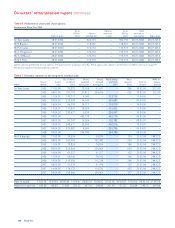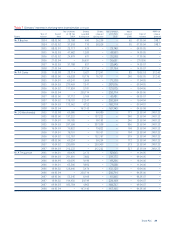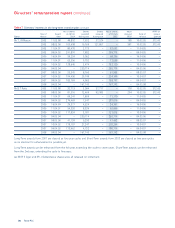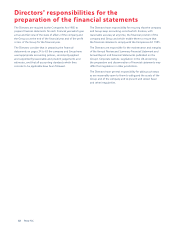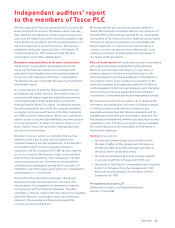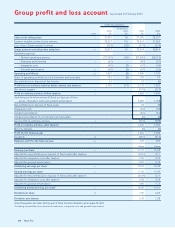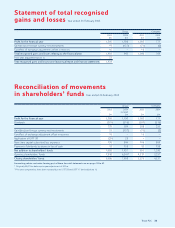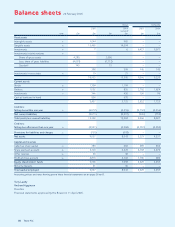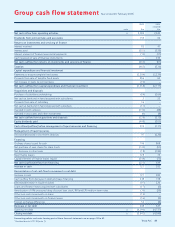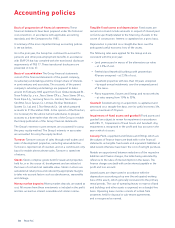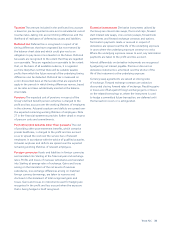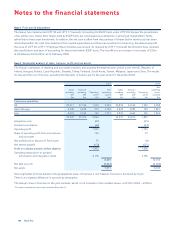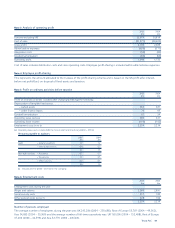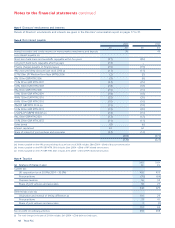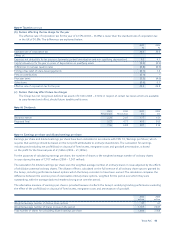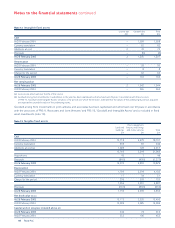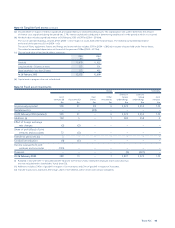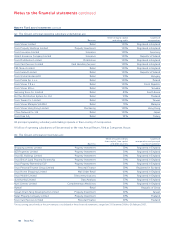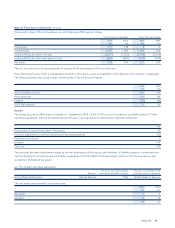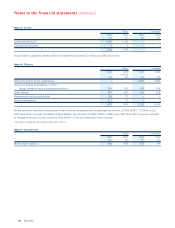Tesco 2005 Annual Report Download - page 40
Download and view the complete annual report
Please find page 40 of the 2005 Tesco annual report below. You can navigate through the pages in the report by either clicking on the pages listed below, or by using the keyword search tool below to find specific information within the annual report.Accounting policies
Basis of preparation of financial statements These
financial statements have been prepared under the historical
cost convention, in accordance with applicable accounting
standards and the Companies Act 1985.
A summary of the more important Group accounting policies
is set out below.
As in the prior year, the Group has continued to account for
pensions and other post-employment benefits in accordance
with SSAP 24 but has complied with the transitional disclosure
requirements of FRS 17. These transitional disclosures are
presented in note 27.
Basis of consolidation The Group financial statements
consist of the financial statements of the parent company,
its subsidiary undertakings and the Group’s share of interests
in joint ventures and associates. The accounts of the parent
company’s subsidiary undertakings are prepared to dates
around 26 February 2005 apart from Tesco Global Aruhazak Rt.,
Tesco Polska Sp. z o.o., Tesco Stores C
ˇR a.s., Tesco Stores SR a.s.,
Tesco Kipa A.S
,., Samsung Tesco Co. Limited, Tesco Malaysia
Sdn Bhd, Tesco Taiwan Co. Limited, Ek-Chai Distribution
System Co. Ltd and C Two-Network Co. Ltd which prepared
accounts to 31 December 2004. In the opinion of the Directors,
it is necessary for the above named subsidiaries to prepare
accounts to a date earlier than the rest of the Group to enable
the timely publication of the Group financial statements.
The Group’s interests in joint ventures are accounted for using
the gross equity method. The Group’s interests in associates
are accounted for using the equity method.
Turnover Turnover consists of sales through retail outlets and
sales of development properties, excluding value added tax.
Turnover is reported net of vouchers and on a commission-only
basis for mobile phone airtime sales. Turnover is stated net
of returns.
Stocks Stocks comprise goods held for resale and properties
held for, or in the course of, development and are valued at
the lower of cost and net realisable value. Stocks in stores are
calculated at retail prices and reduced by appropriate margins
to take into account factors such as obsolescence, seasonality
and damage.
Money market deposits Money market deposits are stated at
cost. All income from these investments is included in the profit
and loss account as interest receivable and similar income.
Tangible fixed assets and depreciation Fixed assets are
carried at cost and include amounts in respect of interest paid
on funds specifically related to the financing of assets in the
course of construction. Interest is capitalised on a gross basis.
Depreciation is provided on a straight-line basis over the
anticipated useful economic lives of the assets.
The following rates were applied for the Group and are
consistent with the prior year:
• Land premia paid in excess of the alternative use value
– at 2.5% of cost.
• Freehold and leasehold buildings with greater than
40 years unexpired – at 2.5% of cost.
• Leasehold properties with less than 40 years unexpired
– by equal annual instalments over the unexpired period
of the lease.
• Plant, equipment, fixtures and fittings and motor vehicles
– at rates varying from 10% to 33%.
Goodwill Goodwill arising on acquisitions is capitalised and
amortised on a straight-line basis over its useful economic life,
up to a maximum of 20 years.
Impairment of fixed assets and goodwill Fixed assets and
goodwill are subject to review for impairment in accordance
with FRS 11, ‘Impairment of Fixed Assets and Goodwill’. Any
impairment is recognised in the profit and loss account in the
year in which it occurs.
Leasing Plant, equipment and fixtures and fittings which are
the subject of finance leases are dealt with in the financial
statements as tangible fixed assets and equivalent liabilities at
what would otherwise have been the cost of outright purchase.
Rentals are apportioned between reductions of the respective
liabilities and finance charges, the latter being calculated by
reference to the rates of interest implicit in the leases. The
finance charges are dealt with under interest payable in the
profit and loss account.
Leased assets are depreciated in accordance with the
depreciation accounting policy over the anticipated working
lives of the assets, which generally correspond to the primary
rental periods. The cost of operating leases in respect of land
and buildings and other assets is expensed on a straight-line
basis. Operating lease income consists of rentals from
properties held for disposal or sub-tenant agreements
and is recognised as earned.
38 Tesco PLC


